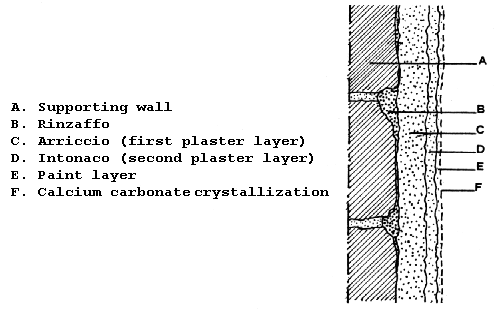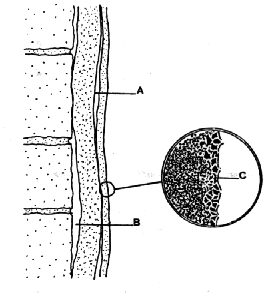
Frescoes are multi-layered structures, which, during human history, have changed their composition many times. What we describe is the structure of the so-called "buon fresco" (XIII-XIV centuries), that served as a base for all the subsequent variations. If you are interested in a detailed description of these techniques, you would not miss the book written by Cennino Cennini in the XIV century, "Il Libro dell’Arte".
Arriccio and intonaco are two similar kinds
of plaster, differing only for granularity and layer thickness. Intonaco
was laid according to the surface the painter could do in a day, so you
can clearly identify the temporal sequence of the creation of the fresco
(the so called "giornate"). Rinzaffo was a mortar used to smooth the wall
surface if it was too rough to correctly apply the arriccio. In the picture
below you can look at a sketch of a typical fresco structure.

At present, structural diagnostics of frescoes
fully relies on the expertise of the restorer and the typical diagnostic
process is accomplished mainly through manual and visual inspection of
the surface of the work of art: for example, to detect voids the restorer
knocks on the fresco and bases his judgement on the sound he hears. The
most important limitations of this technique are the non-objective nature,
the poor repeatability and the high cost. We
are currently studying two innovative diagnostic systems to detect defects
in frescoes; our aims are to locate
detachments and cracks and to define their geometry. .

Here at Ancona we are mainly interested in two defect locations, i.e. at the interface between arriccio and the wall (B) and at the interface between arriccio and intonaco (A).Research is oriented towards the characterization of defects by the study of the surface vibrations of frescoes; to generate such vibrations a sound wave is employed, thus avoiding any contact with the work of art. In the picture below you can see a typical measurement set-up as employed in a church near Ancona.
